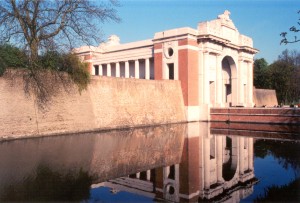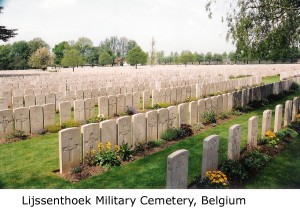During the First Battle of the Marne, the hastily assembled French Sixth Army threatened Kluck’s German First Army’s exposed right flank. There ensued a steady series of troop movements known as ‘The Race to the Sea’ in which both sides attempted to turn the enemy’s flank. Generalleutnant Erich von Falkenhayn sent the German Fourth Army (Duke Albrecht of Wurttemberg) including Beseler’s Corps against Flanders with the aim of capturing Calais. By 14 October, the Belgians were positioned behind the Yser and its canal, and the British 7th Division and 3rd Cavalry Division, forming the new IV Corps, were around Ypres.
15 Battle of the IJzer (Yser): 18 to 31 October 1914
Province: West Flanders
Region: Flanders
Country: Belgium
A French Battlefields “Virtual Battlefield Tour”
Summary: On 18 October, the Germans opened their attack with a heavy artillery bombardment along the entire Belgian line, and followed it with infantry incursions into the forward outposts at Sint Pieters Kapelle, Keiem, and Beerst. An attempt by the German III Reserve Corps to take Westende was beaten back by shellfire from three British monitors lying off the coast. Belgian reserves were largely committed over the next two days while the assaults continued – some forward positions changing hands several times. On 20 October, attention shifted to Mannekensvere, where General Beseler’s corps sent three divisions against three Belgian regiments. Despite bombardment from German 210-mm howitzers, the Belgians held the city, even recapturing Lombardsijde on 22 October.
Also on 20 October, the German 43rd and 44thReserve Divisions started their assault upon Diksmuide against général Meiser’s brigade. On the roads leading into the city, Colonel Jacques and his 12th Regiment of the Line earned fame – and a statue in the Diksmuide town square – with his spirited defense of the approaches from the northeast, east and south. Ronarc’h’s men held the west bank of the river, north of the city. The German preliminary artillery barrage set Diksmuide on fire, while heavy winds spread the flames from house to house across the narrow streets. The cycle of infantry attack followed by artillery fire continued throughout the day. On 24 October, the Germans launched their most determined effort to take the city, launching fifteen waves of infantry after an exceptionally heavy bombardment. The German effort ultimately failed, but the casualties and diminishing supplies of ammunition were weakening the Belgian resistance.
View 15 Battle of the Yser: 18 to 31 October 1914 – A Virtual Battlefield Tour by French Battlefields (www.frenchbattlefields.com) in a larger map


